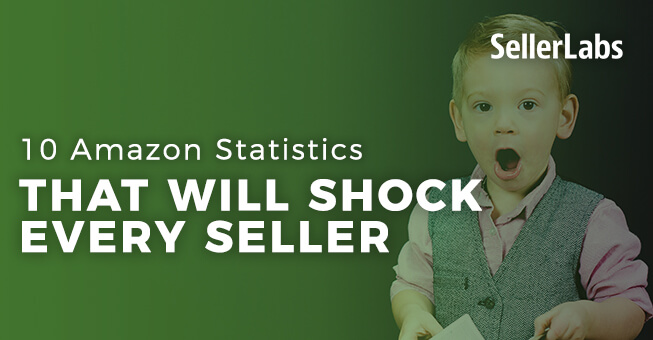Amazon continues to shock sellers and shoppers alike by its ever-growing statistics. Check out these 10 unbelievable Amazon stats.
This guest post is by Erik Mathes, former Content Marketing Manager at Informed.co. In it, he discusses Amazon statistics that provide insight into how sellers can better navigate its marketplaces.
As an Amazon seller, you already know that the Amazon Marketplace is a dog-eat-dog world. Between monitoring your prices against your competitors, managing inventory and shipping, and handling customer service to ensure your store has a top seller rating, you probably don’t have much free time to perform research on your market or on Amazon itself.
On top of that, Amazon is known for keeping its sales figures and customer tallies top secret. That means that finding key metrics to drive your decision-making is tough in and of itself, and the numbers you dig up may not always be up-to-date.
These numbers are indicative of how massive and enlivened the Amazon Marketplace is and will be the perfect starting point for when it comes to weighing important decisions that will affect the future of your Amazon store.
The first five Amazon statistics will paint a picture of the overall size and reach of the Amazon Marketplace, and statistics 6 through 10 will delve deeper into consumer spending habits.
Without further ado, let’s jump into some shocking Amazon statistics!
1. As of 2017, there are more than 300 million active accounts on Amazon.
You’re not reading that wrong.
There are literally hundreds of millions of people using Amazon to make purchases in every category you can imagine. That means there’s room for just about every seller to be successful, pending they focus on delivering the right experience to the customer in every interaction.
One way for sellers to free up time is to focus on customer service by using technology to handle some of the more mundane management tasks, such as repricing and inventory management, so they can put their energy into offering more personalized interactions with customers and creating a superior customer experience.
2. As of 2019, there are more than 100 million Amazon Prime US subscribers.
Amazon Prime is a premium subscription service that offers its members a variety of perks, including access to Amazon’s online movie and music streaming libraries, unlimited image storage, and more.
With people becoming more accustomed to instant gratification, becoming a Prime-eligible seller is clearly in your best interest. According to Fortune, there are more than 100 million Prime members in the US, and that number is growing every day.
3. The #1 reason that Amazon customers become Prime members is…wait for it…FREE Same-, One-, and Two-Day Shipping!
When Amazon Prime members are asked why they choose to pay $119 a year or $12.99 a month for the service, an overwhelming majority — 78%, to be exact — say that it’s because of the free shipping.
So, if you’re an Amazon seller looking to boost sales, it’s vital that you focus on increasing how fast you can deliver your products in order to become Prime eligible. Once you reach this elite seller status, your sales are bound to boost.
4. In 2019, more products were purchased on Prime Day than Black Friday and Cyber Monday 2018 combined.
Amazon has a way of setting trends. Just look at how many retailers are trying to beat the company at its own game. The same holds true for its annual Prime Day sales event, which has become a sort of “Christmas in July.”
More than 175 million products were sold during the 2019 Prime Day two-day sales event. This was Amazon’s largest shopping event ever. In fact, Amazon sold more products in the two days than it did for Black Friday and Cyber Monday 2018 combined.
The craziest part is that Amazon will more than likely surpass the 2019 record in 2020.
5. The average non-Prime Amazon user spends $600 a year. Prime members may spend twice as much — or more.
When it comes to spending habits of Amazon users, it turns out that a Prime member is going to spend a lot more than her non-Prime counterparts.
The reason?
It could be the happy rush that consumers get when they receive instant gratification in the form of 2-day (or faster) shipping. Or maybe seeing the Prime logo next to a wanted item makes it all the easier to click “Buy Now.”
A study from March 2019 found that Prime members spend an average of $1,400 a year on Amazon compared to non-members who spend around $600 a year.
In a 2015 Consumer Intelligence Research Partners study, it was found that Prime members spend $1,500 per year, so it’s fair to assume the true average sales figure falls somewhere between $1,100 and $1,500.
Bottom line: Set your sights on becoming Prime eligible, and your company’s bottom line will get a hefty boost.
6. More than half of online shoppers go directly to Amazon for product searches.
Did you know that 56% of US, UK, German and French shoppers visit Amazon first when doing product research? This stat is hardly surprising considering it seems to be growing year over year.
A study from BloomReach in 2015 found that 44% of online shoppers go directly to Amazon before checking any other site. That number is up from 2012 when a study by Forrester found that 30% of online shoppers bypass the entire web to visit Amazon first when doing research to make a purchase.
7. Nearly 70% of Amazon.com customers used a mobile device to make purchases.
If you didn’t think mobile was a massive part of Amazon, these figures should have you convinced otherwise.
Nearly 70% of Amazon customers used a smartphone or another mobile device to make a purchase during the last holiday season.
And, with the number of people who use Amazon’s mobile app doubling from the previous year, sellers must be sure their product images and descriptions are optimized for mobile users so that they can maximize their share of sales to this growing group of buyers.
8. More than 75% of shoppers do “most” of their holiday shopping on Amazon.
A 2018 CNBC survey found that 76% of consumers plan do their holiday shopping on Amazon. That’s an increase of 25% from 2015 where a Reuters/Ipsos survey of over 3,200 adults found that more than half of shoppers plan to do the majority of their holiday shopping on Amazon.
Compare that figure to the 16% who said the same thing about Wal-Mart, 3% who said the same about Target, and 2% who picked Macy’s as their primary place for presents, and you see just how dominant the Amazon Marketplace has become.
9. Amazon had more than half of total online sales on Black Friday in 2017.
According to Business Insider, 54.9% of all online purchases on Black Friday 2017 happened on Amazon. This breaks down to seven million transactions on Black Friday. All in, this was a 21% increase in market share from 2015.
According to Slice Intelligence, a data company that collects information from packaging receipts linked to its tracking app, Amazon dominated Black Friday in 2015.
What does all of this mean for sellers?
One thing: have your inventory ready — and all your systems in place — well before Black Friday hits in order to maximize your sales and your bottom line during this wild day of online shopping.
10. Nearly twice as many millennials use Amazon Prime compared to baby boomers.
When it comes to consuming on-demand video entertainment, 19% of millennials rely on Amazon Prime for streaming service, versus only 16% of gen-Xers and 11% of baby boomers.
While these Amazon statistics don’t directly tell you much about each of these groups’ shopping habits, it does shed light on who Amazon sellers might want to be targeting with their Prime-eligible products.
Since nearly twice as many millennials are using Prime for video compared to baby boomers, logic dictates that a larger number of younger consumers will be using Prime to make purchases than older buyers.
Smart Amazon sellers who are eligible for Prime should then focus on selling items that are more attractive to a younger demographic.
And there you have it!
We hope these Amazon statistics help you to better navigate the Amazon Marketplace.
And, if you’re curious about improving your sales on Amazon then try out Seller Labs Pro free for 30 days. You’ll get four effective products that will help you advertise smarter, message strategically, discover opportunity and manage your business better.







